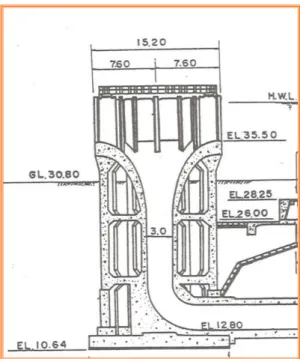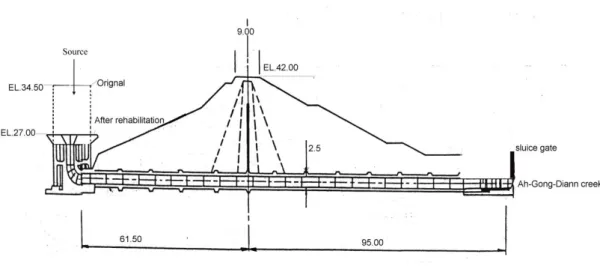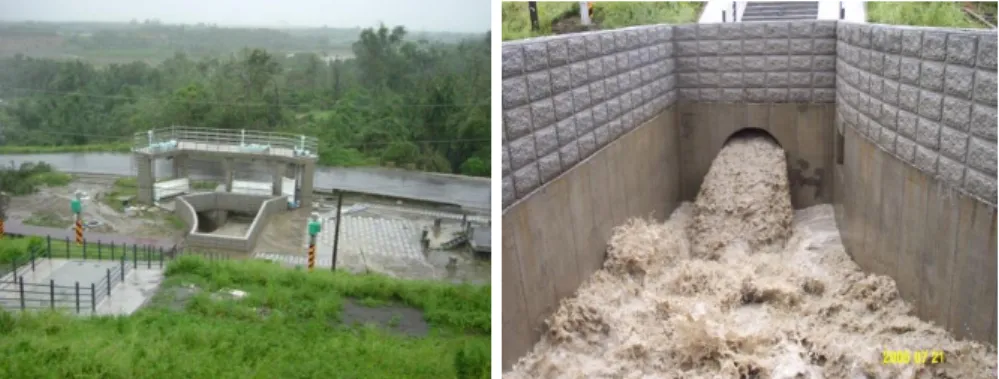-1-
Hydraulic Model Study of The Functions of
Sediment Exclusion by Seasonal Emptying in
Agondian Reservoir
Ching-Hsien Wu1, Chun-Shen Chen2, Chun-Hung Chen3
Abstract
The storage capacity of Agondian Reservoir has been silt up 71%. The sediment deposition was 500,000 m3 yearly in average since 1952 to 1991, which may cause the flood control capacity under the required 50-years return period flood. Thus the Agondian Reservoir renewal project was started in 1997. The plan of improvement includes four items: (1) to construct another spillway going beyond the reservoir watershed, (2) to remould the tunnel spillway as bottom outlet for seasonal emptying of reservoir, (3) to dredge 11,600,000 m3 deposited sediment (4) to construct a transbasin channel for diverting water into the reservoir from another watershed. The hydraulic model test was carried out from 1997 to 2003, indicated that the modified layout can clearly improve the desilting functions of reservoir. Comparison of the desilting functions of various layouts indicates that the better experimental result was 225,200 m3
deposited sediment yearly in average, which could be used for the references of design criteria.
The purpose of this study was to compare the sediment exclusion efficiencies of the model tests and sedimentation survey. The deposited sediment amount of the Agondian Reservoir decreases to 205,600 m3 yearly in average from 2005 to 2017. The differences between the field and the model tests will be recommended for the operation scheme and improvement strategy of the desilting function, and achieving the sustainable development of reservoirs.
Keywords: bottom outlet, tunnel spillway, desilting function, reservoir sedimentation
Authors
1.Ching-Hsien Wu
Engineer, Water Resources Planning Institute, WRA Email: wcs@wrap.gov.tw
2.Chun-Shen Chen
Division Chief, Water Resources Planning Institute, WRA Email: csc@wrap.gov.tw
3.Chun-Hung Chen
Director, Water Resources Planning Institute, WRA Email: ch@wrap.gov.tw
-2- INTRODUCTION
Agondian Reservoir is located at southern part of Taiwan. Due to the loose characteristics of the soil within the catchment, a great amount of soil, in which more than 80 % is of cohesive sediment, was carried into the reservoir with the surface runoff. The geology of Agondian Reservoir is shown in Pic.1. According to the1952~1991 data, 71 % of the storage was occupied by the sediment, which means about 500,000 m3 of sediment was deposited in the storage pond per year. Taiwan Water Resources Agency (WRA) has proposed the “Agondian Reservoir Rehabilitation Plan” to improve the capability and life of the reservoir. The rehabilitation plan suggested to lower the inlet of bell mouth spillway down to near the bed level( EL.27m). Instead of flushing the flood, the reconstructed bell mouth inlet will be used to sluice the inflow sediment. The layouts of the plan are shown in Fig.1. The plan of improvement includes four items: (1) to construct another spillway going beyond the reservoir watershed, (2) to remould the tunnel spillway as bottom outlet for seasonal emptying of reservoir, (3) to dredge 11,600,000 m3 deposited sediment (4) to construct a transbasin channel for diverting
water into the reservoir from another watershed.
Pic.1 Geological Condition of Agondian Reservoir
-3- Experiment Set-up
An experiment (WRA 1997) was conducted to model the sediment sluicing efficiency of Agondian Reservoir by following the rehabilitation plan. The general layout of the simulation area is shown in Fig. 2. The Chuo-Shui Creek and Wang-Lai Creek inflow boundaries were located at transection 36 and 72 respectively. The sediment dredged from the Agondian Reservoir was used for the experiment. In order to obey the dynamic similarity, the Froude number and the ratio of flow velocity and particle fall velocity at rest water, were used as the controlled dimensionless parameters. To avoid the scale effect, the distorted model, in which the horizontal and vertical scales were 1:60 and 1:15 respectively, were used.
Fig.2 Plan layout of model test area
Analysis the Results of Sediment Exclusion by Seasonal Emptying
First, investigating the dynamic similarity and assessing the efficiency of sediment control in a single flood event at the original construction. Then testing and evaluating the desilting function of the reservoir rehabilitation plan, and the additional model amendments including: the different diameters of the remoulded tunnel spillway and the irrigation intake opens and operats as sluiceway(Qmax=15cms)for sluicing the sediment simultaneously by model tests.
1. Desilting functions before reservoir construction in 1955
Analysis of the results of sediment testing with unsteady flows, testing the 50-year and 5-year return-period flood case, to simulate turbidity current and sediment deposited distribution and the sediment exclusion efficiency of a single flood event at the original construction. The crest EL.34.5m of tunnel spillway, diameter=3.0m Qmax=90cms original construction, 1973 added 1.0m on the crest of tunnel spillway, Fig.3. Description of different return-period flood as follows,
-4-
a. Modeling test the 50-year return-period flood case, turbidity current faster cumulated the surface elevation of muddy lake, can flush the higher concentration, the trapping ratio is 89.9% for 50-year return-period flood. b. Modeling test the 5-year return-period flood case, turbidity current slowly
cumulated the surface elevation of muddy lake, can flush the lower concentration, the trapping ratio is 95.5% for 5-year return-period flood.
Fig. 3 Desilting Functions before Agondian Reservoir Construction 2. Rehabilitation Plan for Bell Mouth Spillway
Analysis of the results of sediment testing with unsteady flows, testing the 50-year and 5-year return-period flood case, the results of the tests indicate that the diameter of the remoulded tunnel spillway is reduced to 2.5m. The rehabilitation plan suggested to lower the inlet of bell mouth spillway down to near the bed level. (From EL.34.5m to EL.27.0m) Instead of flushing the flood, the reconstructed bell mouth inlet will be used to sluice the inflow sediment. The layouts of the plan are shown in Fig. 4.
a. The trapping ratio is 72.8% for 50-year return-period flood. Maximum outflow concentration is 23,000 PPM
b. The trapping ratio is 67.7% for 5-year return-period flood. Maximum outflow concentration is 20,000 PPM
-5-
Fig. 4 Cross-section layout of rehabilitation plan for bell mouth spillway 3. Testing the different diameter of the tunnel spillway
The crest EL.27.0m of tunnel spillway, Qmax=5cms and between two diameters: 2.5m and 3.0m testing the 5-year return-period flood case, to simulate the sediment exclusion efficiency of a single flood event in the rehabilitation plan.
a. The trapping ratio is 64.4% for 5-year return-period flood, when the diameter of the tunnel spillway is 2.5m.
b. The trapping ratio is 54.9% for 5-year return-period flood, when the diameter of the tunnel spillway is 3.0m.
When the diameter of the tunnel spillway is maintain in 3.0m, the trapping ratio is less almost 10% then 5-year return-period flood. While the diameter of the tunnel spillway is 2.8m(Qmax=85cms) and the irrigation intake opens and operates as sluiceway(Qmax=15cms) for sluicing the sediment simultaneously, the sluicing discharge which is about 100cms totally. Thus, increase outflow, reduce sediment deposition time and the reservoir water level. The layout clearly improves the desilting functions of the reservoir after testing the different diameter of the tunnel spillway.
4. The results of the desilting functions of the reservoir for 3yrs simulation Based on rainfall, runoff and annual reservoir deposition data, an hourly discharge versus sediment loading relationship was developed for simulation of remoulded tunnel spillway and supplementary irrigation pipe. The simulation was conducted for 18 main storm events from 1955 to 1957. Total amount of silt added was 21.4 M tons while silt deposited in the reservoir was 742,800 tons. Thus the silt sluicing ratio was 65.3%(or the trapping ratio 34.7%). Pic. 2 depicts deposited topograph in the vicinity of the outlet. In the model, average annual silt depositions estimated to be 247,600 tons. Taking a unit weight of 1.1 tons/m3, the annual volume of deposit was 225,200 m3.
-6-
Pic.2 Deposited topograph in the vicinity of the outlet for 3yrs simulation Agondian Reservoir Prevention Efficiency Due to Rehabilitation
Rehabilitation of Agondian Reservoir overflow pipe for reservoir silt mitigation installation of downstream control gate pic.3 and supplementary irrigation pic.4, removal of 11.6 Mm3 of silt from reservoir, constructions of facilities for transbasin
flood discharge and water diversion were completed in June 2005. From 2005 to 2016, for a 12 years period, the reservoir went under empty sluicing, flood control and water supply operation. Fig. 5 compares the rate of reservoir siltation prior to and after the rehabilitation. Main results are as follows:
1. Comparison of desilting effect between model and prototype
Following the rehabilitation, the average annual sedimentation for the 12 year period was 201,000 m3. This is close to the 225,000 m3 obtained from the model test.
Since the ratio of sediment passing through the reservoir was 65.3%, it is judged that approximately the same ratio occurred in the prototype.
2. Comparison of sedimentation prevention efficiency due to rehabilitation From the accumulative siltation data, up to 1981, the volume of siltation was 13.7M m3, which was more than 2/3 of effective storage, and equivalent to an average annual
siltation of 489,000 m3. After rehabilitation, for a 12-year duration, the average annual siltation was 201,000 m3. This reflected an average annual reduction of 58.9% in siltation. Effectiveness of emptying operation during flooding season on reducing reservoir sedimentation is thus obvious.
-7-
Pic.4 After rehabilitation irrigation pipe and downstream control gate
Fig. 5 The rate of reservoir siltation prior to and after the rehabilitation Conclusion and Recommendation
Results of 12 years of empty flushing operation in Agondian Reservoir showed that the average annual siltation was 201,000m3. This is close to the 225,000m3 obtained in a hydraulic model. Hydraulic model indicated that 65.3% of sediments pass through the reservoir. The prototype exhibited the similar sedimentation prevention efficiency.
The average annual siltation. In addition for a 30yr duration prior to the reservoir rehabilitation was 489,000 m3. In comparison with 201,000m3 after rehabilitation, this revealed that siltation prevention effect was apparent. The rate of reduction in reservoir siltation was 58.9%.
Many factors have to be considered on actual siltation prevention operation, including aesthetics of water environment, downstream channel safety and water resources utilization, as well as a potential growth of vegetation on the reservoir bed during reservoir-empty period. Therefore a complete reservoir-empty condition, as in the case of hydraulic model, could be difficult to accomplish. It is suggested that the
-8-
most suitable siltation-prevention period be evaluated. In addition, it would be desirable to set up inflow sediment concentration detection and data transmissiom system plus quantity inflow water resource value versus sediment concentration. These data can be used as the bases for siltation prevention operation.
REFERENCES
1. Hydraulic Model Studies on The functions and operations of Silting Prevention in A-Kung-Tien Reservoir in 1999.
2. Hydraulic Model Studies on The functions and operations of Silting Prevention in A-Kung-Tien Reservoir in 2001.
3. Hydraulic Model Studies on The functions and operation of Silting Prevention in A-Kung-Tien Reservoir(Final Report) in 2003.
4. Study on the operation of sediment prevention for Agongden Reservoir, Chen-Way Yeh Yung-Chau Cen Yein-Ginn Chen Wen-Fu Chen in 2015.
5. Measure program about the sedimentation survey for Agodian Reservoir and Agodian River in 2017.
6. Sediment Observation for Desiltation of Agongdian Reservoir by Using Empty Flushing in 2018.


